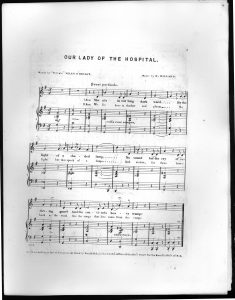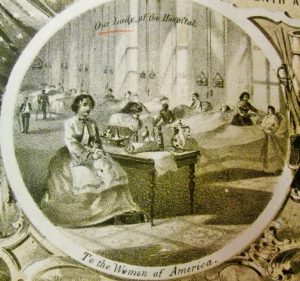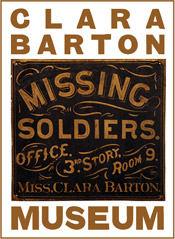“Our Lady of the Hospital”: A Song Dedicated to the Nurses of the Civil War
Written in 1864 by Irish-born Union Army officer Charles G. Halpine, Our Lady of the Hospital is a rare example of a song dedicated to the work of Civil War nurses, singing of the comforting sentiment their presence gave to soldiers on hospital wards. Over the course of four stanzas the song – sung from the perspective of a soldier watching the passage of night on his “long dark ward” – tells the lyrical story of life in “hospital tents and sheds”, soldiers succumbing to death and the night nurse watching over the injured.
Halpine does not shy away from painting a scene of a war hospital and all its realities – the lyrics create the oppressive atmosphere of night on a ward. Even though it is far from the fighting, death and the horror of conflict are inescapable. Wounded soldiers lie “in shadow and gloom…for three hours black as the tomb”, in darkness and in silence “dreadfully deep.” Through his lyrics, Halpine transports listeners to the ward itself, heightens the senses and creates an intense image of what it would have been like to lie in the cold ward, occasionally hearing a fellow wounded soldier “groan” in pain as they turned in their beds, or, as they dreamt of the battlefield sights they had seen, heard them “talk in their troubled sleep.” The penultimate verse describes those who do not make it through the night – the “dozens of men…in trenches” buried, young and old, Union and Confederate soldiers together.

Our Lady of the Hospital, Charles G. Halpine/Miles O’Reilly, 1864 (Courtesy of the Library of Congress)
This was a scene that would have been recognizable to those familiar with the conflict’s hospitals and medical institutions. Halpine, working as a Union staff officer and adjutant, particularly alongside General David Hunter, visited military hospital institutions during the course of the war. The vivid descriptions presented in Our Lady of the Hospital not only reveal his skill as a lyricist in having the ability to paint a rhetorical hospital scene, but also suggest the ballad’s images came from his own memory, recalling oral, aural and visual senses of wartime’s wards at night.
The ballad makes an unusual change from Halpine’s more common lyrical repertoire. The song, according to its musical score, had “words by ‘Private’ Miles O’Reilly.” This was a reference to the fictional creation Halpine conjured during the Civil War when writing satirical, pointed and political ballads aimed at Union society. Miles O’Reilly was a fictional Irish-born soldier employed by Halpine for stories that saw his creation experience all aspects of the conflict, from the battlefield to prisoner-of-war captivity, home-front political arenas to even ‘meeting’ President Lincoln. The majority of his stories and songs – printed in newspapers and published in Life and Adventures, Songs, Services, and Speeches of Private Miles O’Reilly, 47th Regiment New York Volunteers (1864), and Baked Meats of the Funeral, a Collection of Essays, Poems, Speeches, and Banquets, by Private Miles O’Reilly (1866) – were rooted in comic parody.
By contrast, Our Lady of the Hospital had a far more somber tone. O’Reilly’s solemn ‘voice’, set to a slow tune by H. Millard, highlighted that when the subject matters of death, wounded soldiers and wartime hospital realities were sung about, satire was abandoned. Furthermore, unlike most of his songs Halpine did not make O’Reilly the hero of this particular example. Instead, the honor went to “our lady” – the nurse tending to the injured, sleeping men on the ward at night. Her depiction, especially sitting “by the light of a shaded lamp”, recalled Florence Nightingale’s ‘Lady with the Lamp’ imagery. Here Civil War nurses are described as saints, praying as they administer and watch over soldiers.
The song’s final verse mourns the fact nurses were bearing witness to such sights; they weep and share in the sorrow of the wounded and the war-torn nation. In the last two lines, Halpine creates a haunting image of the nurse crying, her silent pitiful response to the scene around her witnessed by the solider singing the song, a sight caught only in the shadow “by the light of the shaded lamp.”

Cover detail, Songs of the War, By Miles O’Reilly, 1864 (Courtesy of the Library of Congress)
When Our Lady of the Hospital was included in Songs of the War, By Private Miles O’Reilly – a musical score book with the lyrics and tunes of five of Halpine/O’Reilly compositions – the illustrated cover captured this same image of a nurse sitting by a lamp as described in the ballad. In the background lie injured soldiers, some with crutches, one with his arm in a sling, tended to by fellow nursing staff. A dedication was placed below the illustration: “To the Women of America.” Charles G. Halpine’s Our Lady of the Hospital was sung for the American Civil War’s nurses above all others.
Endnotes
[1] Our Lady of the Hospital, lyricist Charles G. Halpine (Miles O’Reilly), in Songs of the War, by Private Miles O’Reilly (New York: William Hall & Son, 1864).
About the Author
Catherine Bateson is a PhD student at the University of Edinburgh, researching the sentiments and expressions of Irish American Civil War songs and music. She is also the co-founder of the War Through Other Stuff Society and social media secretary for the Scottish Association for the Study of America. You can follow her on Twitter @catbateson.
Tags: Catherine Bateson, Charles G. Halpine, Civil War, Civil War hospitals, Civil War nurses, Civil War songs, hospitals, Our Lady of the Hospital Posted in: Uncategorized
